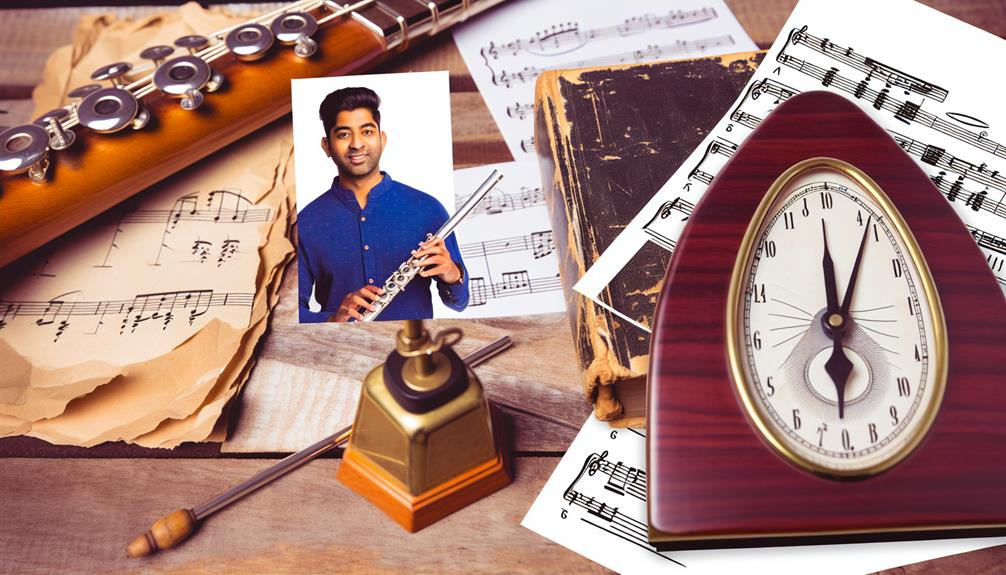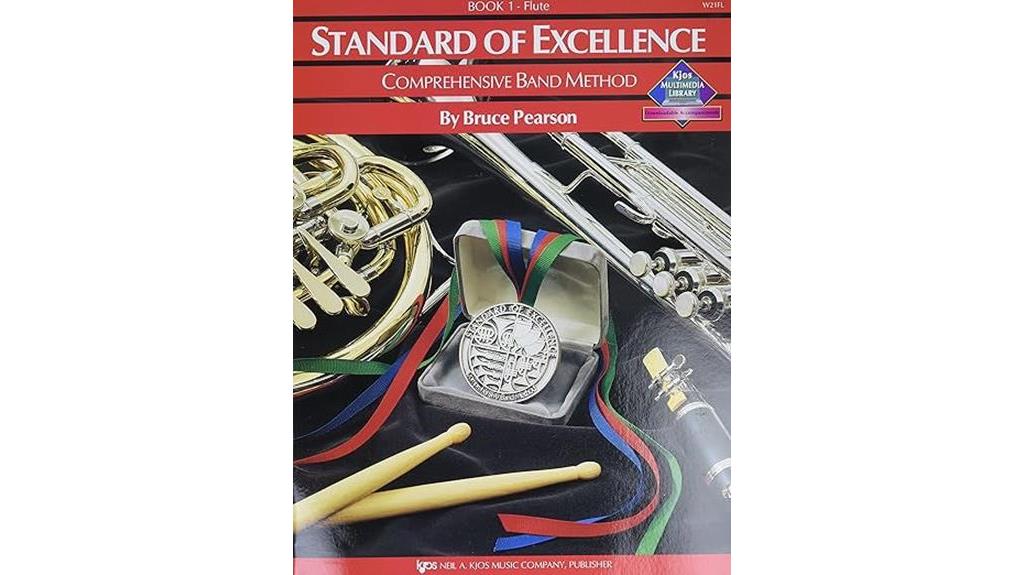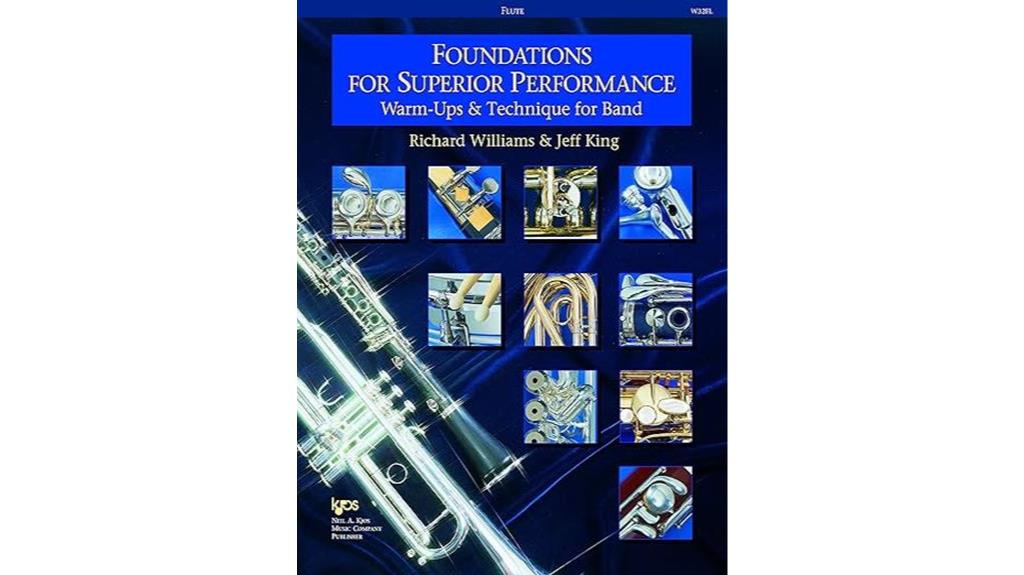The 'Rubank Intermediate Method: Flute' has garnered attention for its structured and all-encompassing approach to advancing flute playing skills. This method book is praised for its focus on key elements such as breath control, articulation, and fingering techniques, offering valuable insights for flutists at various skill levels. User feedback highlights the effective strategies and challenging exercises within the book, but does it truly live up to its reputation? Let's explore the learning experience and insights from those who have utilized this method to enhance their flute playing abilities.
Key Takeaways
- Thorough guidance on advanced flute techniques.
- Structured approach for clear skill development.
- Effective strategies for enhancing flute skills.
- Focus on breath control, articulation, and fingering changes.
- Practice tips for mastering challenging exercises.
Book Overview
What fundamental aspects does the Rubank Intermediate Method: Flute or Piccolo cover for students seeking to advance their flute playing skills?
This book provides a thorough overview of advanced techniques essential for progressing flutists. It explores key elements such as breath control, aiding players in mastering sustained notes and achieving ideal tone quality. Volume control techniques are examined, enabling musicians to navigate dynamics effectively.
Additionally, articulation methods are detailed, enhancing the clarity and precision of musical phrasing. Fingering shifts are also a focal point, ensuring seamless movement between notes.
Furthermore, the book introduces new concepts like syncopation, grace notes, and trilling, expanding the player's repertoire of skills and musical expression.
Rubank Intermediate Method: Flute or Piccolo serves as a valuable resource for those looking to elevate their flute playing abilities through a structured and informative approach.
User Feedback
Users of the Rubank Intermediate Method: Flute or Piccolo have consistently praised the book for its thorough guidance and effective strategies in enhancing flute playing skills.
Many users have shared improvement suggestions, such as incorporating more challenging exercises to further advance skills. Additionally, practice tips like focusing on specific techniques before moving on to new lessons have been highlighted by users as beneficial.
The book's structured approach has been commended for providing a clear path for skill development. Some users have also mentioned the importance of regular practice and patience when using the Rubank method to see significant progress.
Learning Experience
Drawing from the wisdom provided by flute players who have found value in the Rubank Intermediate Method, the learning experience with this educational resource involves a systematic and thorough approach to enhancing flute skills. Improvement techniques within the book focus on advanced concepts like breath control, articulation, and fingering changes, offering a structured path for skill development.
Practice tips are strategically integrated to help learners master new techniques, such as syncopation, grace notes, and trilling. Users appreciate the book for its clarity in music instruction, making it a valuable tool for both beginners and experienced players.
The Rubank Intermediate Method is praised for its effectiveness in improving flute skills and aiding in the retention of abilities, especially after extended breaks from playing.
Frequently Asked Questions
Are There Specific Exercises for Improving Breath Control in This Book?
In the Rubank Intermediate Method: Flute, specific exercises focusing on breath control are provided to enhance a player's technique and performance. Long tones, a fundamental practice for improving breath support, are included in the book's repertoire.
Additionally, the method introduces various techniques aimed at refining breath control, ensuring players develop the necessary skills for achieving peak sound quality and musical expression on the flute.
Does the Book Provide Guidance on Playing in Different Time Signatures?
The book explores time signature exploration, providing techniques for playing in various time signatures. It offers insights into rhythmic variation and practice strategies, enabling students to master the complexities of different time signatures.
Are There Tips for Mastering Challenging Fingering Transitions?
Mastering challenging fingering changes requires developing finger dexterity through dedicated practice routines.
Focus on passage techniques and finger coordination to enhance fluency.
Start with slow, deliberate movements to build muscle memory, gradually increasing speed as proficiency grows.
Incorporating scales, arpeggios, and exercises specific to challenging changes can further refine skills.
Consistent practice and attention to proper technique are essential for mastering intricate fingering passages on the flute.
How Does the Book Address Issues With Tone Quality and Dynamics?
In addressing tone quality, the book offers essential tips on breath control, embouchure adjustments, and proper air support techniques to produce a clear and resonant tone.
Moreover, it includes exercises focused on dynamics, such as crescendos, diminuendos, and accentuation, to help musicians develop control over volume variations and expressiveness in their playing.
These detailed strategies enhance the overall musicality and performance quality of flute players at an intermediate level.
Does the Book Offer Strategies for Incorporating Expression and Musicality in Playing?
To enhance musical interpretation, the book suggests incorporating emotion through various techniques. Strategies include utilizing different articulations, dynamics, and phrasing to convey the intended mood of the music.
Performance is elevated by focusing on nuances such as subtle changes in tempo, tone color, and expressive ornamentation. By emphasizing these elements, players can infuse their playing with greater depth, emotion, and musicality for a more engaging and impactful performance.
Conclusion
To sum up, the 'Rubank Intermediate Method: Flute' serves as a valuable tool for flutists seeking to advance their skills.
With its structured approach, detailed instruction, and challenging exercises, this method book offers a pathway to mastering advanced flute techniques.
By emphasizing the importance of patience and consistent practice, flutists can achieve peak tone quality and precision in their playing, like a sculptor carving out intricate details in a masterpiece.





